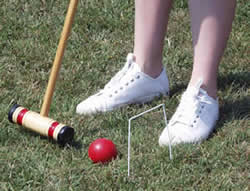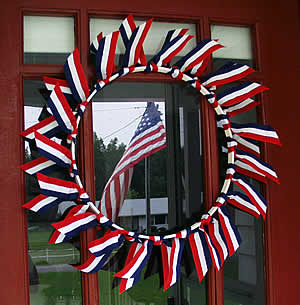Summer Fun With Croquet
 Transform your own backyard into an arena of summer fun competition – try croquet. That’s right, croquet. It’s the game you played once in your Aunt Judy’s backyard that reminded you of miniature golf. You may even have a set of wooden mallets and colored balls in your garage, aching to be used. Why not give it a try this summer? It’s fun, free (after you buy the initial set), and easy to set up. Better yet, it does NOT provide an aerobic workout, so it’s perfect for those warm August evenings. Old or young, tall or short, athletic or not, anyone can play and enjoy croquet.
Transform your own backyard into an arena of summer fun competition – try croquet. That’s right, croquet. It’s the game you played once in your Aunt Judy’s backyard that reminded you of miniature golf. You may even have a set of wooden mallets and colored balls in your garage, aching to be used. Why not give it a try this summer? It’s fun, free (after you buy the initial set), and easy to set up. Better yet, it does NOT provide an aerobic workout, so it’s perfect for those warm August evenings. Old or young, tall or short, athletic or not, anyone can play and enjoy croquet.
Croquet stems from an ancient Roman game in which balls were hit with sticks towards specific trees on a course. As this game evolved, the trees became holes for golf when the course was large. When space was more confined, paille-maille developed in France. Around 1830 croquet was developed by a French doctor as a version of paille-maille that his patients could play. The game spread to Ireland, England, and beyond as toy companies began producing croquet sets and self-appointed experts wrote rule books. Croquet was introduced in the United States around 1865. Its popularity has risen and fallen, but croquet has experienced a revival in the United States in the past 20 years.
 Today many versions of croquet are played on tournament courses and in backyards across the country. While some rules vary, the main elements are the same: players hit colored balls with mallets through wickets, attempting to finish the course ahead of the other players. Here are some basic terms and rules, focusing on “backyard croquet” to get you started:
Today many versions of croquet are played on tournament courses and in backyards across the country. While some rules vary, the main elements are the same: players hit colored balls with mallets through wickets, attempting to finish the course ahead of the other players. Here are some basic terms and rules, focusing on “backyard croquet” to get you started:
1. Croquet is played with 2-6 players. For team play, the “hot colors” (red, orange, yellow) play against the “cool colors” (blue, green, black).
2. The course is about 50 feet by 100 feet, but can be decreased depending on the area available. It is optional to mark the boundary with string. The turning/finishing posts (wooden stakes with colored stripes) are set at each end of the course, at the half-way mark.
3. When playing the casual “9-wicket” game, the wickets are set up in a two-diamond formation, with an extra wicket between the diamond ends and the turning/finishing posts.
4. The order of play is determined by ball color. Follow the color order on the turning/finishing posts. Consult your croquet set manual for exact wicket set-up and the order for passing through wickets.
5. Bonus strokes are earned in three ways: one for passing through a wicket, one for striking the turning post, two for striking another ball (see roquet below).
wicket – metal or plastic three-sided stake through which the ball passes.
mallet – wooden stick with cylindrical head used for striking the ball (color-coded to match the ball).
roquet – occurs when one ball strikes another. The striker proceeds with a croquet stroke, then a continuation stroke.
croquet – first stroke after a roquet. The striker’s ball is placed next to or one mallet-head’s length from the struck ball. Both balls are then hit. (When placing them side-by-side, place your foot on the top of your own ball so as not to send it too far.)
continuation stroke – second stroke after a roquet. The striker uses this stroke to continue on his/her course for the game.
For casual backyard play, the instruction manual that comes with your set should give you enough information. For those of you who enjoy (and crave) the nitty-gritty details and rules, there are many sites on the internet that will satisfy you. Just remember to follow a basic rule of SUMMER – have fun!





